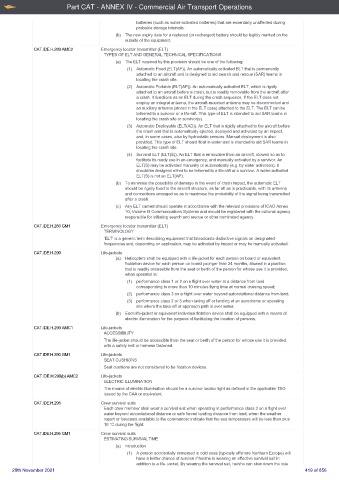Page 419 - UK Air Operations Regulations 201121
P. 419
Part CAT - ANNEX IV - Commercial Air Transport Operations
batteries (such as water-activated batteries) that are essentially unaffected during
probable storage intervals.
(b) The new expiry date for a replaced (or recharged) battery should be legibly marked on the
outside of the equipment.
CAT.IDE.H.280 AMC2 Emergency locator transmitter (ELT)
TYPES OF ELT AND GENERAL TECHNICAL SPECIFICATIONS
(a) The ELT required by this provision should be one of the following:
(1) Automatic Fixed (ELT(AF)). An automatically activated ELT that is permanently
attached to an aircraft and is designed to aid search and rescue (SAR) teams in
locating the crash site.
(2) Automatic Portable (ELT(AP)). An automatically activated ELT, which is rigidly
attached to an aircraft before a crash, but is readily removable from the aircraft after
a crash. It functions as an ELT during the crash sequence. If the ELT does not
employ an integral antenna, the aircraft-mounted antenna may be disconnected and
an auxiliary antenna (stored in the ELT case) attached to the ELT. The ELT can be
tethered to a survivor or a life-raft. This type of ELT is intended to aid SAR teams in
locating the crash site or survivor(s).
(3) Automatic Deployable (ELT(AD)). An ELT that is rigidly attached to the aircraft before
the crash and that is automatically ejected, deployed and activated by an impact,
and, in some cases, also by hydrostatic sensors. Manual deployment is also
provided. This type of ELT should float in water and is intended to aid SAR teams in
locating the crash site.
(4) Survival ELT (ELT(S)). An ELT that is removable from an aircraft, stowed so as to
facilitate its ready use in an emergency, and manually activated by a survivor. An
ELT(S) may be activated manually or automatically (e.g. by water activation). It
should be designed either to be tethered to a life-raft or a survivor. A water-activated
ELT(S) is not an ELT(AP).
(b) To minimise the possibility of damage in the event of crash impact, the automatic ELT
should be rigidly fixed to the aircraft structure, as far aft as is practicable, with its antenna
and connections arranged so as to maximise the probability of the signal being transmitted
after a crash.
(c) Any ELT carried should operate in accordance with the relevant provisions of ICAO Annex
10, Volume III Communications Systems and should be registered with the national agency
responsible for initiating search and rescue or other nominated agency.
CAT.IDE.H.280 GM1 Emergency locator transmitter (ELT)
TERMINOLOGY
‘ELT’ is a generic term describing equipment that broadcasts distinctive signals on designated
frequencies and, depending on application, may be activated by impact or may be manually activated.
CAT.IDE.H.290 Life-jackets
(a) Helicopters shall be equipped with a life-jacket for each person on board or equivalent
floatation device for each person on board younger than 24 months, stowed in a position
that is readily accessible from the seat or berth of the person for whose use it is provided,
when operated in:
(1) performance class 1 or 2 on a flight over water at a distance from land
corresponding to more than 10 minutes flying time at normal cruising speed;
(2) performance class 3 on a flight over water beyond autorotational distance from land;
(3) performance class 2 or 3 when taking off or landing at an aerodrome or operating
site where the take-off or approach path is over water.
(b) Each life-jacket or equivalent individual flotation device shall be equipped with a means of
electric illumination for the purpose of facilitating the location of persons.
CAT.IDE.H.290 AMC1 Life-jackets
ACCESSIBILITY
The life-jacket should be accessible from the seat or berth of the person for whose use it is provided,
with a safety belt or harness fastened.
CAT.IDE.H.290 GM1 Life-jackets
SEAT CUSHIONS
Seat cushions are not considered to be flotation devices.
CAT.IDE.H.290(b) AMC2 Life-jackets
ELECTRIC ILLUMINATION
The means of electric illumination should be a survivor locator light as defined in the applicable TSO
issued by the CAA or equivalent.
CAT.IDE.H.295 Crew survival suits
Each crew member shall wear a survival suit when operating in performance class 3 on a flight over
water beyond autorotational distance or safe forced landing distance from land, when the weather
report or forecasts available to the commander indicate that the sea temperature will be less than plus
10 °C during the flight:
CAT.IDE.H.295 GM1 Crew survival suits
ESTIMATING SURVIVAL TIME
(a) Introduction
(1) A person accidentally immersed in cold seas (typically offshore Northern Europe) will
have a better chance of survival if he/she is wearing an effective survival suit in
addition to a life- jacket. By wearing the survival suit, he/she can slow down the rate
20th November 2021 419 of 856

